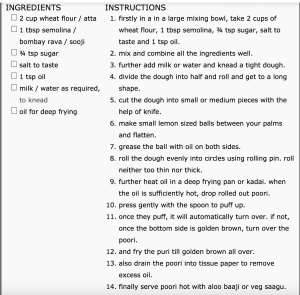Food is arguably the most important part of Indian culture. Indian food has become popular worldwide because of the unique taste, appearance, and experience that accompanies eating our food. When I think about all the different dishes I have had the privilege of eating growing up in a Gujarati household, I start to imagine the mouthwatering taste of Bataka Nu Shak (Potatoes) or the slight burn on the lip after eating paneer tikka masala. However, I believe the subtle puri (Pūri) has been the most impactful on me. The puri exemplifies how the most “simple Indian dishes” maintain a strong presence among the diet of Indians worldwide, including myself. Puris are deep fried bread that are made with cumin seeds, red masala, ghee, and other ingredients. Although the recipe may seem plain, every chef who cooks them has their own method that results in a different size, texture, and taste. I believe that the variation of puris has come about as a result of the varying Indian states which use different ingredients and cooking techniques that have been handed down from generation to generation. Out of all the puris I have tasted my grandmothers is by far my favorite as she manages to keep the inside light and fluffy while having a contrasting crispier edge. However, my aunt has earned the title of second best puri with a less traditional, more thin and chip like bread with a good balance of fluff and crunch.


During my visit home this summer, my Ba and I made puris on Sunday morning. The plate to the right has paaper, gatya, red masala gatya, and Puris.
Every Sunday morning I would help my Ba (grandmother) make warm puris to eat with our breakfast, which typically contained a lot of other Indian snacks as well as chai tea. Similar to a lot of other international families, every meal was eaten together so this dish holds a lot of nostalgia to simpler times in which I made many good memories with my family. Most Indian functions would also serve puris with shaak (typically a vegetarian dish with vegetables and spices that can be either spicy or sweet) including weddings, engagements, house blessings (Puja), birthdays, and trips to the mandir (temple). Specifically, I can remember going to the mandir for Hindu festivals (like Diwali-the festival of lights) and getting plates of foods with crispy puris, bataka nu shak (potatoes with vegetables) , and rice. The combination of bright fireworks, wearing fancy red/gold kurtas, and eating traditional food has allowed me to become more knowledgeable about my culture and history.
Today puris are a staple food among Indians, however the history of this classic dish can be traced all the way back to the books of the Mahabharata which were composed in the 8th and 9th century. I have actually read pieces of the Mahabharata which is a huge epic that describes a war raging between two cousins. It contains philosophical and religious wisdom that is on par with the intelligence of the gods. The god I am named after, Lord Krishna, also makes a guest appearance in this fearsome battle. As the epic goes on, Draupadi’s mother in law gave her leftover potato and enough wheat dough to make one puri with the task of making enough food to feed her 5 sons. And although I would have failed this task miserably, Draupadi invented the pani puri which is the classic puri filled with shak. After nearly 10 centuries the puri has evolved through is travel throughout India and now there are so many types of puri including Aloo Ki puri, puris, luchi, and Masala Puri. Similar to what I discussed earlier the style of puri is heavily influenced by the geographic location of the chef and the flavor/ingredients that thrive in certain areas.


Hi, Dominic, I’ve certainly learned a lot from your post about your favorite dish, puri, and about Indian food in general. I’m delighted to read your comments on the variations of puris and the disparate regional differences. Your grandmother’s puri sounds amazing, as does your aunt’s. Thanks for the lovely photos! I can imagine how delicious it must be, eating puris and drinking chai for breakfast, along with other traditional snacks. You connected foods with the culture and history of a country, which I believe to be very true. I wish you would elaborate on what that influence has done to you, and how your identity or self-understanding has changed over the years, especially as you have to stay away from home after entering college.